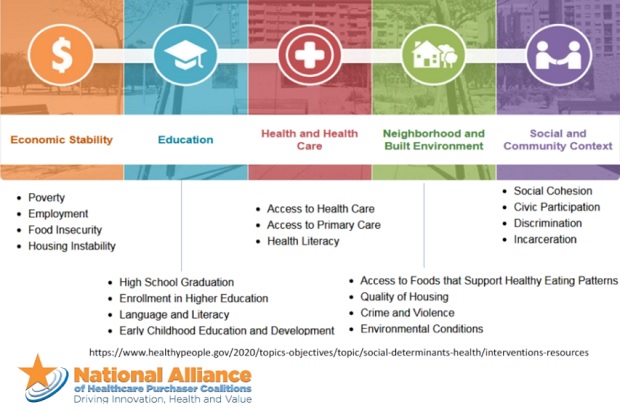 Factors such as education, environment, social and community relationships and economic stability contribute not only to an individual's risk of contracting COVID-19, but their likelihood of a successful recovery. (Photo: Shutterstock)
Factors such as education, environment, social and community relationships and economic stability contribute not only to an individual's risk of contracting COVID-19, but their likelihood of a successful recovery. (Photo: Shutterstock)
As employers grapple with the impact of the COVID-19 coronavirus on their business, ensuring the health and safety of their employees remains top of mind for many. Beyond concerns about whether their workers will contract the virus and transmit it to coworkers and what can be done to protect them, there's also a growing focus on the well-being of employees as they struggle with financial and mental stress.
In a recent webinar, the National Alliance of Healthcare Purchaser Coalitions addressed one essential but potentially overlooked aspect of employers' response to the pandemic: Social determinants of health.
Indeed, factors such as education, neighborhood and built environment, social and community relationships, economic stability and more contribute not only to an individual's risk of contracting COVID-19, but their likelihood of a successful recovery, as well. For example, studies have pointed to the greater risk posed by the virus among African-American communities, where underlying conditions such as diabetes, asthma and heart disease are more prevalent.
Related: Social determinants of health playing a bigger role in doctor visits
"If we don't begin to understand the underlying systems that are driving these outcomes, we can't get ahead of them," said panelist Somava Saha, MD, MS with Wellbeing in the Nation. "Businesses didn't create these issues, but they have an important role to play in taking on these underlying issues."
Beyond the health implications, these same SODH hold significant sway in an individual's ability to weather the economic uncertainty currently gripping our country. The panelists highlighted a few of the key SDOH affecting employee communities during this chaotic time, offering up not just food for thought but actionable steps for employers.

Income insecurity and financial well-being
There's a big difference between how hourly and salaried employees are affected by the current situation. Cristie pointed out that hourly workers are hourly more likely to be working in jobs that put them at greater risk, and for many, not working is simply not an option.
Meanwhile, many salaried employees have the luxury of being able to work from home. Where they face less risk. But SDOH can even affect an individual's ability to work remotely, with access to the internet and other digital resources a key element that's not available in every area.
For employers forced to lay off or furlough workers, there are a number of resources they can turn to to help soften the blow. "UnitedWay typically has their finger on the pulse for non-profits, particularly federally qualified health centers," said Shelly Duncan, a member of the Kansas Business Group on Health. "I want to also mention: We also know that as more people are at home, more laid off, we're going to see increases in domestic violence, abuse of children. It doesn't matter what your economic status is, but employers need to be mindful of that and provide employees resources for that, too."
Food insecurity
Most communities have already experienced the effects of panic and hoarding during the pandemic: Grocery store shelves empty not just of toilet paper and hand sanitizer, but canned goods, frozen foods and fresh meat. Unfortunately, not everyone has the luxury of stocking up on essential foods, and those whose budgets limit them to buying food for just a few days at a time are really struggling now.
Elizabeth Colyer, senior vice president of Community Well-Being Index at ShareCare noted that one of its recent surveys found that more than 25 percent of people have less than six days' supply of food. Another SDOH that compounds the issue of food insecurity: living in a food desert, and having to drive (or ride a bus) several miles only to find out the essentials you're looking for aren't there. Moreover, there's a not insignificant population of school-aged children who relied on free or reduced school lunch programs who are now spending their days at home.
"That's a major issue every employer needs to consider," added Jessica Brooks, a member of the Pittsburgh Business Group on Health. "It might not just be certain populations on SNAP… this is a commercial employee population issue as much as it is a poverty issue."
It might be an uncomfortable topic, but employers can find ways to help their workers facing food insecurities. "Employers that do have the ability to provide access to free or discounted meals, it's a need we're seeing a lot of employees have," said Lauren Remspecher, from the St. Louis Area Business Health Coalition. "Set up food or meal distribution sites. Use delivery workers who have been displaced. There are some creative opportunities to use those people to meet some of the social determinants we've been talking about."
Environmental factors
Returning to the issue of greater COVID-19 risks among African American populations, Saha attributed this, in part, to the role of structural determinants of health, such as living in a neighborhood located closer to factories or other sources of pollutants. "We're seeing now that the relationship between lifetime levels of air pollution and exposure and much higher rates of death among African-Americans," Saha said.
"Employers are part of the community whether they see themselves in that relationship or not," she added. "The increasing ability of employers to apply that lens that recognizes toxic stress that the employees and their family on the bottom fifth of their workforce will lead to a higher rate of having chronic diseases in the next decade. Our voice is powerful in terms of zoning and where businesses can and can't be. And our ability to say we're going to hire from groups that were excluded in the past."
The built environment will also affect the impact of self-quarantine and stay-at-home orders. For those who have access (and can afford) delivery services and have a nearby park where they can go for a daily walk, the time will pass much more easily. However, without such amenities, we can expect greater issues related to mental stress and isolation.
"The issue of stress is additive and cumulative," noted Michael Thompson, NAHPC president & CEO. "If you look out three weeks from now, it doesn't matter. It's going to get bigger and bigger. We're seeing this as a parallel epidemic, if not pandemic, likely to occur in the mental health arena."
Time to think about your benefits plan differently
The panelists also stressed how employers can do more to address SDOH with their benefits plans. In particular, shifting more from focusing on clinical services to social services. According to Thompson, "What's been coming for employers is this idea that their benefit plans are being required to accommodate social services in ways that employers always acknowledged were important but never understood how the unmet needs impact employees' ability to go back to work."
But at a time when employers are shutting down production and tightening their belts, adding benefits just isn't an option for many. "Not every benefit plan currently in place can handle some of the social services arising in need," said Remspecher. "I would highly recommend American Academy's Neighborhood tool. For those organizations that don't have the capacity to expand internally, it's a great way to be partnering."
Brooks also noted that employers can work with their health care network to continue to offer health care access to employees after their employer insurance is discontinued. In addition, there is a range of voluntary benefits that don't have to be tied to an employer, such as telemedicine programs.
If nothing else, think about how social determinants of health affect the benefits you're already paying for. Brooks pointed to the disparate health outcomes for different racial groups receiving the same services. "Employers are paying the same amount for their white mother and black mother to have a baby, and the black mother might die because of implicit bias or might not get the same medications," she said. "We're paying the same amount of money. That's an employer issue."
Read more:
© 2025 ALM Global, LLC, All Rights Reserved. Request academic re-use from www.copyright.com. All other uses, submit a request to [email protected]. For more information visit Asset & Logo Licensing.








